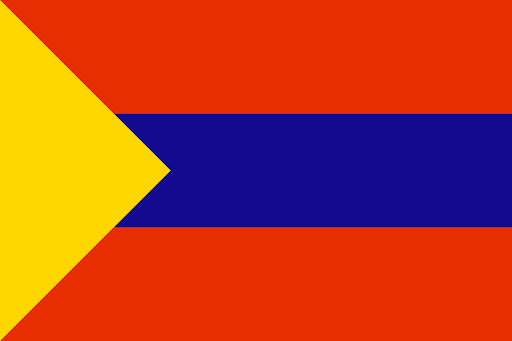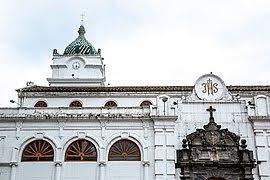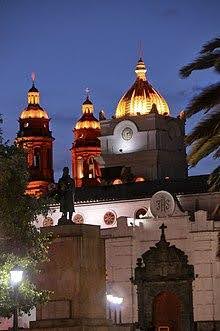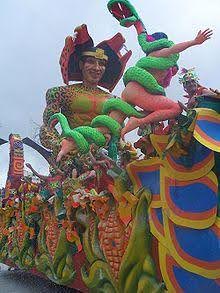San Juan de Pasto
Department

Flag of the city
The flag of San Juan de Pasto, a vibrant municipality in Colombia’s southwest, showcases its rich heritage with three equally-sized stripes: vermilion red borders the top and bottom, while navy blue graces its centre. Accentuating its left side is a distinctive yellow isosceles triangle, rotated 90° to the right, with its apex pointing toward the flag’s heart.
Located in the Andean region, Pasto serves as Nariño’s capital. It boasts a bustling economy, particularly in the realm of arts and crafts. Interestingly, indigenous pastures inhabited this area before Spanish colonization. Historical records suggest that San Juan de Pasto, the municipal seat, underwent two foundational phases in 1537 and 1539. Despite Pasto’s deep-rooted history, it wasn’t until 1967 that the desire for distinctive municipal symbols arose. This sentiment culminated on May 23, 1967, when the Municipal Council of Pasto unanimously accepted Ignacio Rodríguez Guerrero’s flag design. Henceforth, it became an essential emblem, representing both the mayor’s office and Deportivo Pasto, the local soccer team.
Each flag colour tells a story. Vermilion red epitomizes Pasto’s fierce spirit, reflecting courage, bravery, and heroism. Navy blue pays homage to the beauty, fearlessness, justice, and unwavering loyalty of its residents. The flag’s standout feature, the golden-yellow triangle, embodies the wisdom, perseverance, and benevolence of Pasto’s inhabitants. Local folklore suggests that those born here possess innate knowledge. For official events, the flag, measuring 1.35 meters by 1.10 meters, stands tall on a 2.50-meter pole.


Slogan of the city
San Juan de Pasto is also known as the “Surprise City” (Ciudad Sorpresa) due to its unexpected charms. Another moniker, the “Theological City” (Ciudad Teológica), speaks to its profound religious and theological roots. The city’s proximity to the Galeras Volcano gives it the title “Galeras’s Land” (Tierra Del Galeras). Furthermore, its historic significance is encapsulated in its motto: “Very Noble and Very Loyal City of San Juan de Pasto” (Muy Noble Y Muy Leal Ciudad de San Juan de Pasto).
History
The name “Pasto” originates from the indigenous Pastos tribe, who were present in the region when the Spanish conquerors arrived. Interestingly, the Atriz Valley was populated by the Quillacingas. In the Colombian census of 2018, 163,873 individuals identified as Pasto, and in Ecuador’s 2010 census, the number was 1,409.
The city of Pasto was initially established in 1537 by the Spanish explorer Sebastián de Belalcázar. Two years later, another Spaniard, Lorenzo de Aldana, relocated the city to where it stands today, renaming it “San Juan de Pasto.” An Italian named Guido Bucheli played a significant role in boosting Pasto’s economy and growth.
Since colonial times, Pasto has served as a pivotal administrative, cultural, and religious hub for the region, earning it the title of Colombia’s theological city. During the wars for independence against Spain, Pasto supported the royalists. This political allegiance, coupled with its geographical position, resulted in Pasto’s prolonged isolation from the rest of Colombia after gaining independence

Geography of the city
Some parts of the city, particularly near the Galeras Volcano — which has a height of 4,276 meters — reach elevations above 3,000 meters. San Juan de Pasto is geographically situated at a latitude of 1.2147° N and a longitude of 77.2785° W. The city rests at an elevation of approximately 2,527 meters, which translates to about 8,291 feet above sea level.
Heading south for about 80 km, one encounters Ipiales, famous for the mesmerizing Las Lajas Sanctuary. Further west, at a distance of roughly 220 km, lies the coastal city of Tumaco. The drive between Pasto and Tumaco offers a visual treat, transitioning from the mountainous Andes to the shores of the Pacific. To the north, around 138 km away, is the historical city of Popayán, distinguished by its charming whitewashed colonial structures. Meanwhile, the town of Tuquerres sits just 90 km to the northeast. Venturing 250 km to the east, one can discover Mocoa, a gem situated in the Amazon basin, known for its rich natural beauty.
According to the Köppen climate system, Pasto experiences a unique warm-summer Mediterranean climate, primarily influenced by its altitude. This climate mirrors the wet season typically seen in southern hemispheric regions, like the southern part of Quito. Even though Pasto is near the equator, its high elevation ensures moderate temperatures year-round. Daily highs generally hover between 15 and 18°C (59.0 and 64.4°F), while lows are usually in the range of 9 to 11°C (48.2 to 51.8°F). The city receives an average annual rainfall of about 800 millimeters or 31 inches.

Population
397,000 (2023)
394,000 (2022)
In 2023, the metropolitan population of Pasto stands at 397,000, marking a growth of 0.76% from the previous year. In 2022, the population was 394,000, reflecting a 0.77% rise from 2021’s count of 391,000. Similarly, 2021 saw a 0.77% growth from 2020’s figure of 388,000. Going further back, in 2020, there was a 0.52% increase in the population from the 2019 number.
One photo representative of the city
The Church of Saint John the Baptist stands as a testament to the rich history of Pasto, Colombia. Initially serving as the city’s cathedral, its foundation dates back to the 1537 directive of Spanish conqueror Sebastián de Belalcázar. Within its confines, the church holds the remains of the renowned Pastuso independence leader, Agustín Agualongo, and a venerated image of San Juan Bautista, significant to the city’s founding.
Interestingly, the site’s first church was a humble structure with walls made of bahareque and a thatched roof, constructed in the same year. By 1541, a new church emerged to replace the original under the guidance of the city’s first parish priest, Don Diego Gómez de Tapia. The significance of this edifice is highlighted by the decision to ring its bells in 1559, commemorating Pasto’s elevation to city status.
However, the onslaught of earthquakes between 1580 and 1616 left this structure in ruins. Recognizing the importance of the site, Antonio Ruiz de Navarrete oversaw the construction of a replacement, which was inaugurated in 1667. This church forms the foundation of the present structure, which has undergone various renovations, changes, and restorations over the years.
From 1859, this church was designated as the city’s Cathedral, a title it held until the unveiling of the present Cathedral. Afterward, it took on the name ‘Co-Cathedral’. Architecturally, the building boasts a stone facade on 18th Street and a Spanish Baroque style side entrance on Carrera 25, overlooking Plaza de Nariño. A notable interior feature is the baroque pulpit, one of Nariño’s oldest religious art pieces.
The church’s decor exemplifies syncretism, blending external influences with regional elements, evident in native flora ornamentations. This temple also holds significance for being the location where Pasto was officially recognized as a city, termed “very loyal”, and named after its patron saint. The remains of Captain Hernando de Ahumada and the valiant Pastuso leader, Agustín Agualongo, rest within its confines.
The Church of Saint John the Baptist is represented on the Nariño department’s official shield, symbolizing spiritual resilience. The shield’s violet temple denotes magnificence and strength, while its red backdrop stands for passion, bravery, and love. The shield’s silver star symbolizes the brilliance of regional intellect, creativity, and determination, qualities emblematic of the region’s populace
.


Etymology
The origin of the word “Pasto” is linked to the indigenous Pastos tribe that lived in the area when the Spanish explorers arrived. Although the Atriz Valley was home to the Quillacingas, it’s the Pastos name that became associated with the region. According to the 2018 Colombian census, 163,873 individuals identified themselves as Pasto, and in Ecuador’s 2010 census, 1,409 people claimed the same identity.
What the city is known or famous for
The Carnival of Blacks and Whites (Carnaval de Negros y Blancos) stands as southern Colombia’s premier festival. While its roots lie in the city of Pasto, other municipalities in Nariño and southwestern Colombia have embraced it. Held from December 28 to January 7, the event draws significant numbers of both national and international tourists.
In 2009, UNESCO recognized the festival as an Intangible Cultural Heritage of Humanity. The carnival is a testament to the blend of Andean, Amazonian, and Pacific Coast cultures. Originating in 1546, it is unique, especially due to its timing, which aligns with the indigenous celebration of the Moon (Quilla). This reflects rituals of the Pastos and Quillacingas tribes who celebrated harvest seasons with moon dances and sun prayers.
Spanish influence merged with these indigenous celebrations, leading to a religious amalgamation. During the 19th century, authorities tried to curb these festivals to prevent uprisings. By 1834, native festivities resumed, synced with religious events like the Feast of Our Lady of Mercy and the Immaculate Conception.
The eve of the Epiphany also saw the “negritos” game, mainly involving whites and mestizos due to Pasto’s sparse black population. This was an anomaly for a typically quiet community, offering them a chance to break the norm. The game’s origin was a “holiday” for blacks from the Gran Cauca region, to which Pasto belonged. After a 1607 slave uprising in Remedios, Antioquia, Popayán’s significant black population demanded a day of true freedom. In response, the Spanish Crown declared January 5 a holiday for people of color. Celebrations involved painting Popayán’s white walls black, a tradition that spread south to Pasto.
The Whites’ game started in 1912, marking the Epiphany. In a brothel, a group, including Ángel María López and Máximo Erazo, smeared perfumed powder, exclaiming, “Long live the Whites!” This countered the Negros game. Soon, people exiting the Epiphany Mass joined in, shouting support for both Blacks and Whites.
By the 1920s, the festival evolved, becoming more urban and inclusive. In 1926, university students dressed up and paraded, marking the first official parade on White Day, January 6. On January 4, 1929, a parade featured a fictitious family, the “Castañeda Family,” which became an emblematic part of the celebration.
In the 1950s, the floats in the parade became more dynamic and larger, with artists like José Eduardo Ordóñez and Alfonso Zambrano leading the way. By this time, Pasto’s municipal government began to assume a larger role in organizing the festivities. The late 1960s saw international orchestras, like Los Melódicos de Venezuela, being hired for the event. The 1960s also introduced the Carnavalito, or Children’s Carnival, a separate event that eventually became part of the official carnival schedule.


